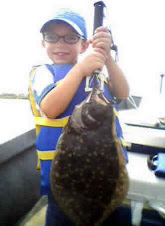By Ron Brooks
Somewhere back in my years I got hooked on flounder fishing. I guess it may have been the way my wife prepares the real butter sauteed fillets with toasted sliced almonds and lemon juice. Makes my mouth water just thinking about it! At any rate, flounder are one of my favorite fish to catch. And it took a while for me to learn to catch them.
Spending most of my younger years in South Florida, I missed out on flounder fishing, because the flounder population there is sparse. They prefer cooler waters I think.
Flounder Migration
One particular flounder trip I was on put me in some nice fish, fish that were making their fall migration to deeper water. It was out of Mayport, Florida, and we were fishing the intracostal waterway in and around the mouth of the St. Johns River.
Flounder make a regular migration to deeper water, and settle in the sandy bottom as far as 25 to 30 miles offshore. They will lay in the sand around any natural structure, or around any of the numerous artificial reefs and wrecks. Spearfishermen take some huge flounder around these wrecks in the winter months.
Targeting the fish
My style is to catch them during their migration. From about September through the end of November, they begin to move out of the creeks and rivers and into the ocean. They have spent the spring and summer months spawning and last year’s crop is now large enough to make the migration with the older brood fish. This years hatch is left in the estuaries to grow another year before making any moves. This is why we still catch a large number of very small flounder all the way through the winter. And it is also why longer length restrictions can play a big part in increasing the stocks.
Tackle
My standard tackle is a medium stiff semi-fast taper 7 foot casting rod with a small baitcasting reel – I like the Abu Garcia 5500C on a freshwater bass flippin’ stick. I use 14-pound test line, small enough to be somewhat invisible, and yet large enough to handle other larger species that may take the bait. The terminal tackle is what I call a standard flounder rig: a 4/0-circle hook on a 15 inch 30 lb. test monofilament leader. The leader is tied to a trolling sinker, and the sinker is tied to the line. These sinkers are the type that look like they have a small beaded chain on each end. They are long and slender, and are ideal for dragging across the bottom.
Bait
The bait I use will vary, but by far I prefer a finger mullet between three and four inches long. Smaller mullet are too small for the hook, and larger ones are too large for some of the flounder to get a hold of easily. As the migration moves from September, these finger mullet get hard to find.
If I can’t find any finger mullet, I will opt for mud minnows. With mud minnows, I switch from the terminal tackle I described. I remove the sinker and tie a 2/0-jig head to the end of the leader. If mullet and mud minnows are both scarce, I will opt for live shrimp and use them with the jig head. And if there simply is no live bait, I will go with a pink or red plastic grub tail on the jig head. There have been days that the fish would hit the grub tail better than live bait! Go figure!
Sunday, April 11, 2010
Subscribe to:
Comments (Atom)







